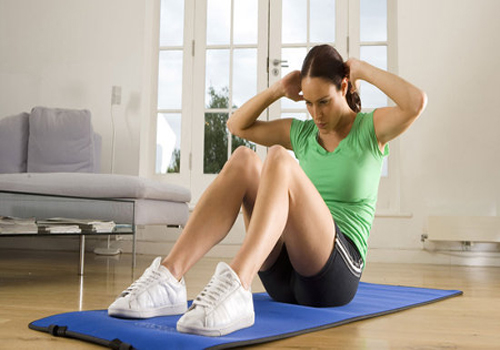
Exercises are meant to make us fit and healthy. Several health problems can be treated or improved with proper and regular exercises. But exercises, if done without proper knowledge, may even harm our body in several ways. Nobody is perfect and may have one or the other illnesses. And certain kind of exercises may aggravate the problem instead of relieving it. For instance, back pain and neck pain are common ailments today. Certain intense exercises like the ones stated below should be avoided by people suffering from neck pain.
Sit ups
Sit ups are one of the most popular exercises which are done to burn extra calories and to keep the body fit. Almost every fitness conscious person may practice this exercise without even understanding the possible side effects of it. Once practiced, this exercise is easy to perform. But the strain that it exerts on the neck and back muscles may lead to aggravation of neck or back pain. In this exercise, the body completely relies on back and neck muscles to reach the desired pose. And in the process, you may exert severe pressure on the neck muscles.
The exercise is done by forcefully elevating the upper portion of the body to touch the knees while lying flat on the ground, and the head is kept straight supported with palms. In this exercise, you must not exert pressure on the neck with hands while trying to lift the body. This is a wrong procedure which may worsen neck problems. Hence, it is better to avoid the exercise if you are suffering from neck pain. Or at the most, practice it under the supervision of an expert. You may also practice crunches instead of sit ups, as those provide the same results without straining the neck muscles as much as sit ups.
Alternative exercise: Crunches
Salabhasana or locust pose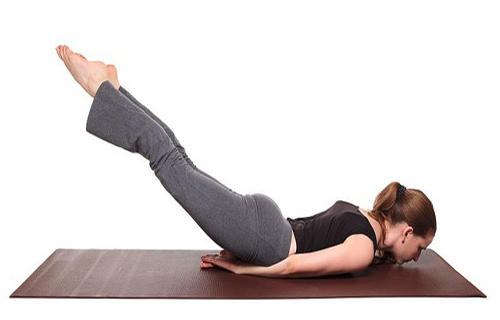
This exercise is intended to strengthen the muscles of back, belly and legs. The body is kept flat on the ground while either both the legs or one leg at a time, are lifted. And the pressure of the whole body remains on the anterior side of upper body and on the chin. The neck is kept straight above the ground and is balanced on the chin. Hence, you are required to exert much force on the neck muscles to maintain the body balance while trying to lift the legs. This exercise can be very straining on the neck and may lead to severe neck pain if you are already suffering from neck problems. Apart from that, the exercise may lead to tearing of the already weakened neck muscles. Hence, it is better to avoid the pose if you are already suffering from neck problems like spondylitis.
Halasana or plow pose
Halasana or the plow pose is another exercise which a neck pain patient should normally refrain from. This is an advanced pose, which calls for a lot of expertise and flexibility. So, if you are a beginner and are also suffering from neck problems, then it is better that you avoid this particular pose. The pose is practiced by lying flat on the back and then lifting both the legs to touch the floor behind the head.
The process is quite intense and may worsen neck pain by exerting excess pressure on the muscles of the neck. The body is balanced solely on the neck while performing the exercise and may lead to sudden injuries if not performed correctly. But it may be practiced carefully in steps under the observation of a professional trainer. On the other hand, you may substitute the pose with the hamstring stretch, as that is far less strenuous on the muscles of the neck.
Alternative exercise: Hamstring stretch or forward bending in seated posture.
Dhanurasana or bow pose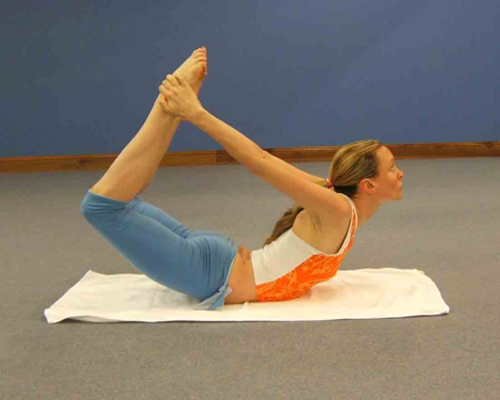
Dhanurasana is very helpful for improving back pain by strengthening the muscles of back. But it may exert a sudden, jerking force on the neck. The exercise is done by lying flat on the stomach. The legs are then lifted and pushed backward to be grasped with the hands. The head is positioned straight, pointing towards the front. Remaining in the pose for more than 2-3 seconds may exert significant amount of pressure on the neck muscles, as the neck is not supported by anything. Hence, if you are practicing this pose in spite of having neck pain then refrain from practicing it for more than 5-6 seconds at a stretch. Release the pose after 5 seconds; take some rest and then repeat it for another 5 seconds. This process should definitely help you practice the exercise without subjecting your neck muscles to strain. As an alternative, you may practice the reverse of dhanurasana (chakrasana), as that has the same effects on the back muscles, with much lesser strain on the neck.
Alternative exercise: Chakrasana
Navasana or boat pose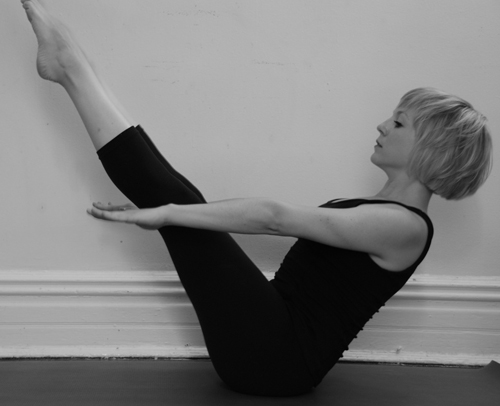
There are two types of boat poses that may be done to strengthen the muscles of back, stomach and legs, but it may be equally strenuous on the muscles of the neck. To perform the advanced pose, you must first practice the ardha navasana or the half boat pose. The pose is done by lifting both the upper part of the body and the legs in air to form a boat like shape. You may feel pressure on the muscles of the neck, but avoid stiffening the neck or bending the neck in a backward direction. Bending may injure your neck. Always keep your neck straight and loose while performing this exercise. Make sure that you perform the exercise only under the supervision of a trainer for a few days before practicing it alone in your home. Do not maintain the pose for more than 5 seconds at a stretch. Dog pose may be practiced as a more comfortable alternative to the navasana.
Alternative exercise: Adho Mukho Svanasana or dog pose
Setu bandhasana or bridge pose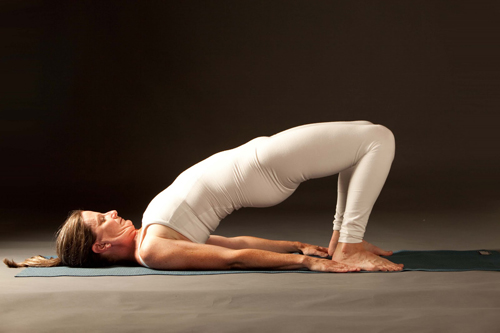
Although the bridge pose is not very difficult, it may definitely subject the neck muscles to strain. The entire body is elevated and balanced on the neck muscles, feet and the head. The twisting movement of the neck muscles may aggravate neck pain and may even injure the neck in case of weakened neck muscles. To perform the pose, one must first lie straight on the ground with two hands kept beside the body. The legs are then folded and the feet are placed flat on the ground. Finally, the entire body is lifted up to form a bridge like shape keeping only the head and neck on the ground. The neck may feel pressure while the body is being lifted up. So, if you are a beginner and have a medical history of neck pain, then you should first consult your doctor and perform the exercise only under the close supervision of your fitness trainer. As a precaution, release the pose whenever you feel excess pressure on your neck.
Bhujangasana or cobra pose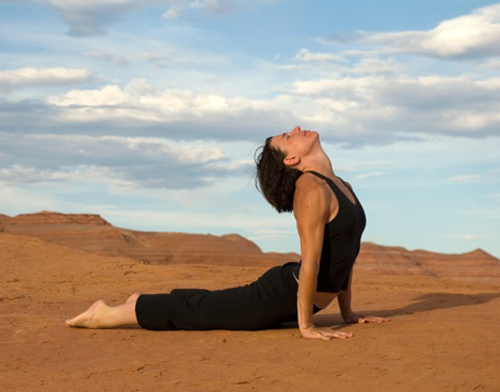
Cobra pose is not very difficult or strenuous, but it definitely exerts pressure on the muscles of the neck. Hence, if you have neck ailments, then it is better to practice the pose only after consulting your doctor and under the guidance of your trainer. Do not maintain the pose for more than 3-4 seconds at a stretch if you have neck problems. As a precautionary step, do not subject your head and neck to intense forward or backward bends as this may strain the muscles of the neck.
Sarvangasana or shoulder stand pose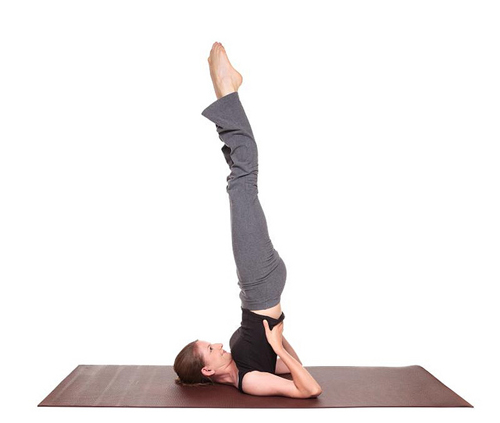
This is a highly advanced pose and is not at all meant for those who are suffering from neck problems. This is because the entire body is balanced on the neck and shoulders in this asana and therefore exerts a huge amount of pressure on the neck. If done forcefully or without precautions, the posture may even lead to tearing of neck muscles and severely injure the bones of the neck.
To practice the posture, first lie flat on the ground and keep the hands beside your body. Then slowly lift both your legs and try to reach over your head with your toes and touch the ground. Finally, lift your back and support it with your hands. Then try to lift your legs one at a time straight towards the ceiling. The pose exerts huge force on the vertebral column of the neck. Hence, it is strictly recommended to consult your doctor before you continue to practice this pose. And if you are a beginner, try to master the pose gradually before trying to do it at once. Consult your fitness trainer about your neck problem and try to practice the pose under his or her supervision.
Alternative exercise: Viparita Karani or legs up the wall pose
Sirsasana or head stand pose
Sirsasana should be performed only when you have already learned to balance your entire body on the neck or shoulder. The pose can be very dangerous to the weakened muscles of the neck because the entire body pressure comes down on the neck while performing the asana. Hence, stop practicing this exercise if you have undergone any surgeries of the neck or if you are suffering from neck ailments like spondylitis. This pose should not be performed even under expert supervision, as it may seriously aggravate neck pain.


